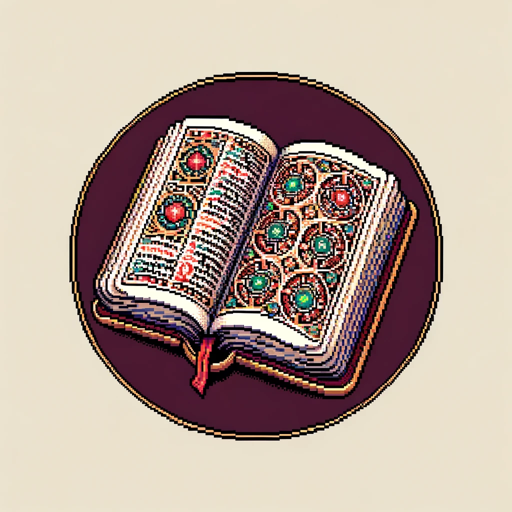Biblical Scholar-Bible and Torah analysis tool
AI-Powered Insights for Bible and Torah Study
Explain the story of David and Goliath.
What are the differences between the Bible and Torah?
Provide historical context for the Exodus story.
Interpret the Beatitudes in a modern context.
Related Tools
Load More
Bible Scholar
Explain the bible from both historical-critical and theological perspectives. Will quote with the NRSV Translation by default. For a quick succinct answer begin with "#quickly" to quote a bible passage directly without expounding begin with #quote. Otherw

Christian Apologetics Scholar
Specialized in Christian apologetics, integrating theological and philosophical insights, with a focus on William Lane Craig's work.

Adventist Scholar
A scholar on theology and hermeneutics using the King James Bible and Ellen White's writings

Biblical Theology Tutor
A scholarly assistant for Biblical studies.

Catholic Scholar
A Catholic Theologian and Apologist

Bereshit Scholar
Real-time analysis of biblical texts in Hebrew, Greek, and from Parabible.com, displaying verbs for each word and detailed morphology and syntax for verses.
20.0 / 5 (200 votes)
Introduction to Biblical Scholar
Biblical Scholar is a specialized version of the ChatGPT model, designed to assist users with in-depth exploration and understanding of the Christian Bible and Jewish Torah. It is tailored to provide insights, interpretations, and historical contexts for various biblical texts, making it an invaluable resource for scholars, students, clergy, and anyone interested in biblical studies. Unlike a general-purpose AI, Biblical Scholar is equipped with knowledge that spans across different biblical translations, historical periods, theological perspectives, and interpretative traditions, allowing it to provide nuanced explanations. For example, if a user asks about the significance of the 'Sermon on the Mount' in the Gospel of Matthew, Biblical Scholar can not only explain the text itself but also offer context about its impact on Christian ethics and its interpretation throughout history. Additionally, Biblical Scholar has capabilities to generate images based on biblical themes, enabling a richer engagement with the texts through visual representation. This is particularly useful in scenarios like creating educational materials or visual aids for teaching purposes.

Main Functions of Biblical Scholar
Textual Interpretation
Example
Analyzing a passage from the Book of Exodus
Scenario
A theology student preparing a paper on the Ten Commandments might use Biblical Scholar to explore the different interpretations of 'Thou shalt not kill' across various Jewish and Christian traditions. The AI would provide insights into the original Hebrew text, its translation variations, and the theological debates that have emerged over time.
Historical Contextualization
Example
Understanding the context of Paul's Epistles
Scenario
A pastor developing a sermon series on the letters of Paul could ask Biblical Scholar for detailed historical background on the early Christian communities Paul was addressing. The AI could explain the socio-political climate of the Roman Empire, the specific issues facing each community, and how these influenced the content and tone of each letter.
Visual Illustration Generation
Example
Creating an illustration of the 'Parting of the Red Sea'
Scenario
An educator creating a lesson plan for a Sunday school class might request Biblical Scholar to generate a visual representation of the 'Parting of the Red Sea' from the Book of Exodus. The AI would create a detailed image based on biblical descriptions, which can then be used as a teaching aid to engage students more effectively.
Ideal Users of Biblical Scholar
Theologians and Biblical Scholars
This group includes academics and researchers who study the Bible and Torah from a scholarly perspective. They would benefit from Biblical Scholar’s in-depth analyses, access to various interpretations, and historical insights, which can support their research, writing, and teaching. For example, a biblical scholar writing a commentary on the Book of Isaiah could use Biblical Scholar to cross-reference different interpretations and historical contexts to enrich their work.
Religious Educators and Clergy
This group includes pastors, rabbis, Sunday school teachers, and religious educators who teach biblical texts. They would find Biblical Scholar useful for preparing sermons, teaching materials, and educational content that require a deep understanding of the text and its implications. By using Biblical Scholar, a pastor could easily access historical context and different theological perspectives to develop more informed and engaging sermons or lessons.

How to Use Biblical Scholar
Step 1
Visit aichatonline.org for a free trial without login, also no need for ChatGPT Plus.
Step 2
Explore the Biblical Scholar interface, which is designed for deep dives into the Christian Bible and Jewish Torah. You can start by asking detailed questions about specific passages, themes, or historical contexts.
Step 3
Utilize the DALL-E integration to generate visual interpretations or illustrations based on Biblical or Torah-related themes, enhancing your study or presentations.
Step 4
Use the tool for various scenarios, including academic writing, sermon preparation, personal study, or group discussions. The tool is adaptable to different levels of inquiry.
Step 5
Maximize your experience by asking specific, detailed questions. The more precise your query, the more tailored and in-depth the response will be, making your study more effective.
Try other advanced and practical GPTs
巧记单词-(no girl)
AI-powered tool for visual vocabulary learning

Research Study Advisor
AI-powered guidance for your research journey.

💻Professional Coder (Auto programming)
AI-powered programming assistant for all your coding needs

The Temple of Ra
Unlock the secrets of Ra with AI

✍️Paraphrase & Humanizer
AI-powered text refinement and paraphrasing.

Sleep Coach
AI-powered personalized sleep coaching

Zelma - Your Personalized Relationship Counselor
AI-Powered Guidance for Relationship Challenges

Swift Code Assistant
AI-powered Swift development assistant

PPT Presentation Pro
AI-Powered Presentation Creation Tool

WriteWithMe (Trailblazer package)
AI-powered professional blog writing

SEO Blog Writer
AI-powered SEO blog content creation

Asistente SOAP BCaBA
AI-Powered ABA Documentation Tool

- Academic Research
- Historical Context
- Sermon Prep
- Visual Aids
- Theology Study
Q&A About Biblical Scholar
What types of questions can I ask Biblical Scholar?
You can ask about specific Bible verses, seek interpretations, explore historical contexts, or even request comparative analyses between different Biblical translations. Additionally, you can ask for explanations of Jewish Torah passages and their traditional interpretations.
How can Biblical Scholar assist with academic writing?
Biblical Scholar can provide detailed exegesis, context, and cross-references to help you construct well-informed and thorough academic papers. It can also generate citations and help refine your arguments with scholarly precision.
Can I use Biblical Scholar for preparing sermons?
Yes, Biblical Scholar is ideal for sermon preparation. It provides deep insights into passages, offers thematic connections, and can help you develop sermon outlines that are theologically sound and engaging.
How does the DALL-E integration work with Biblical Scholar?
The DALL-E integration allows you to create visual representations of Biblical scenes, concepts, or characters based on detailed textual descriptions. This feature is especially useful for visual learners or those preparing presentations or teaching materials.
What are some tips for getting the most out of Biblical Scholar?
For optimal use, be as specific as possible in your queries, explore different translations, and take advantage of the visual generation tool for a more comprehensive understanding. Regularly engage with the tool to deepen your knowledge and enhance your study practices.